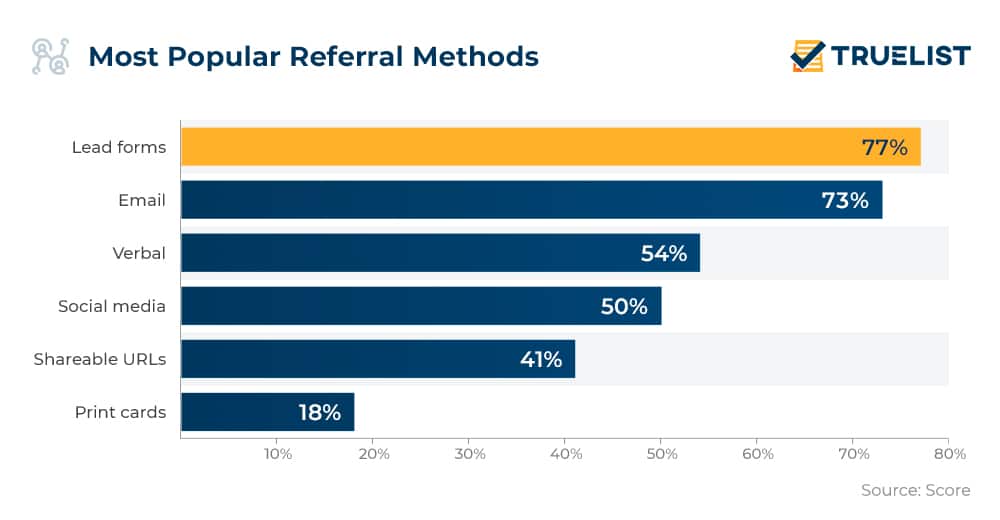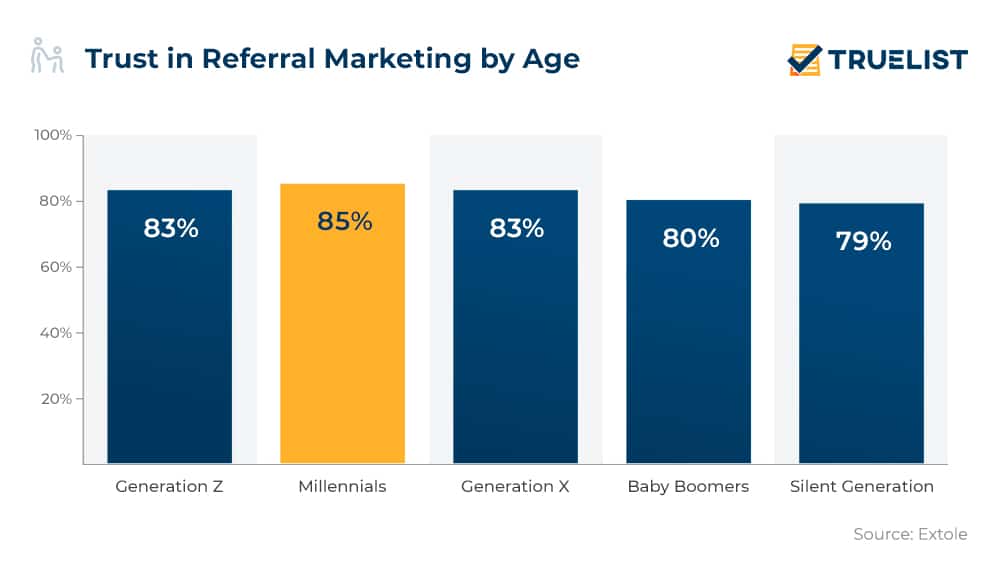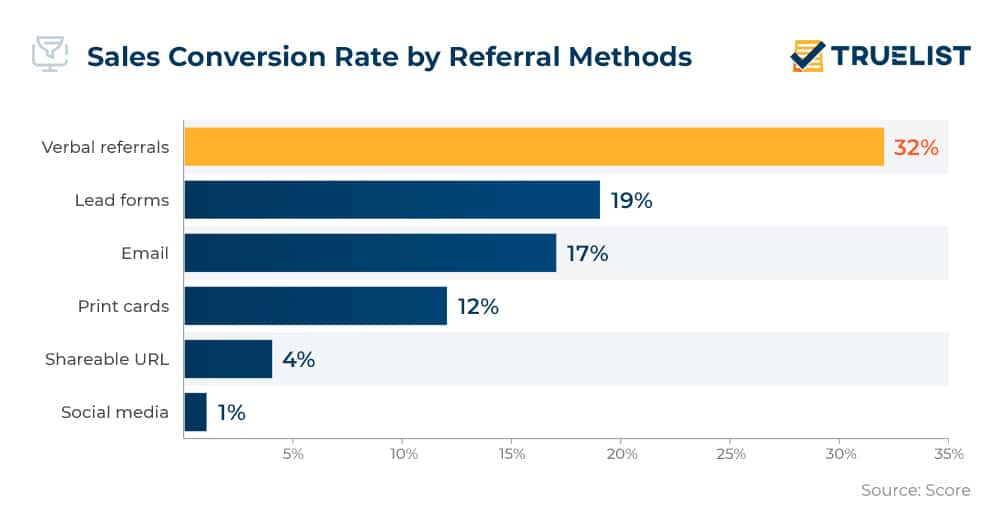With recent studies being all in agreement that referrals are one of the most effective forms of marketing, it’s never too soon to include them into your repertoire for promoting your business. That’s why we’ll take a look at some interesting referral marketing statistics that will help you understand just how powerful this strategy can be. So whether you’re just starting with your venture or you’re looking for new and innovative ways to grow your brand, just keep reading.
Referral Marketing Statistics (Editor’s Choice)
- Referred customers generate 16% more profits. (Extole)
- Only 30% of companies have a sales referral program. (Forbes)
- 29% of referrals come from social media, while email accounts for 23%. (Score)
- 82% of upper management claim word of mouth creates the best leads. (Get The Referral)
- 83% of customers say they want to give a referral but only 29% do. (Referral Rock)
Referral Marketing Stats
1. Lead forms are used as a referral method 77% of the time.
Lead forms are the top referral method for both B2B and B2C owners, followed by email with 73%. Word of mouth ranks in third with 54%, followed by social media with 50% and shareable URLs with 41% to round up the top five referral methods for businesses. Owners, however, also report that 29% of referrals come from social media and 23% from emails.
(Score)

2. Marketers point to referrals as one of the best sources of quality leads.
Referral marketing stats put referrals up there with content marketing in terms of high-quality leads. Unlike content marketing, however, referrals require a minimum initial investment. That’s why 54% of marketers note that the cost-per-lead is lower than with the use of other channels.
(Forbes)
3. Millennials trust referral advertising the most.
With 85%, this generation is the most susceptible to referrals. 28% of millennials won’t even glance at the product if their friends don’t like it. Gen Z and Gen X are close by, with 83% each, referral statistics show.
(Extole)

4. Call to action after purchase makes buyers 16 times more likely to share.
In fact, 83% of customers are willing to refer after a good experience, as a company you don’t need a better referral advertisement than this percentage. They are also four times more likely to share if you include the call to action along the way while they are shopping and not as a separate part of the website, according to referral stats.
(Extole)
5. Up to 78% of marketers agree word of mouth is the ultimate strategy to get more leads.
Word of mouth is a great way to get new customers and it’s been proven to boost the effectiveness of marketing efforts by an enviable 54%. It’s no wonder then that 87% of B2B referral marketing sales representatives and 82% of upper management say word of mouth provides the best leads, referral marketing stats reveal.
(Get The Referral)
6. 51% of companies with referral programs see them as effective for maintaining their sales pipelines.
This compares to 32% of those that don’t have a referral program. Then, some 55% of companies with a referral program find their sales efforts to be highly effective, while 35% of those without a referral program are not as successful.
(Get The Referral)
7. Verbal referrals have the best results in sales with a 32% conversion rate.
When it comes to referral rates, social media is great for getting leads, but it’s not so good at converting them, referral statistics show. That’s why word of mouth is still the best way to get people into your business. Lead forms account for 19% of conversions, followed by email with 17% to round out the top three.
(Score)

8. People are four times more likely to make a purchase after a referral from a friend.
Customers are more likely to become loyal and spend money when they are referred by a friend which is another factor that makes referral programs incredibly valuable for any company. Referral marketing statistics further indicate that clients that come through referrals have a 37% higher retention rate as well.
(Extole)
9. Gift cards are the best incentives for making referrals with a 52% score.
If you want more referrals from your customers, consider handing out gift cards. Or at least that’s the most successful method. If you need more referral marketing examples to entice your customers in exchange for referrals, consider checks (29%), bill credit (9.5%), or merchandise (9.5%).
(Score)
10. 83% of customers are willing to refer but only 29% do so in the end.
How do you make that ratio more favorable? Referral marketing statistics show that timing is everything and choosing the right moment for a call to action is crucial. Having a referral program backed by referral marketing software can help you zone in on the “aha” moment, defined as the time when your customer experiences the most value from your product/service. That could be right after marking the purchase, getting the product in the mail, or receiving a complementary post-purchase gift and/or discount code.
(Referral Rock)
11. Small businesses get 60% of their business through referrals.
Up to 86% of companies that use referral strategies see growth in their business over two years. These referral stats are particularly important for small ventures, where 82% of owners claim their new business comes mainly through referrals, according to small business stats.
(Hubspot, Invesp)
12. B2B companies with referrals have a 70% higher conversion rate.
They have a 69% faster close time on sales as well. And there’s another thing, referrals have a loop effect — those who were referred to your business are more likely to give a referral as well. Referring customers make more referring customers. Despite these positive B2B referral statistics, only three out of 10 B2B businesses have a formalized referral program.
(Think Impact, Extole)
13. A 2% referral rate is generally seen as good.
The referral rate is the number of purchases your business gets from referrals compared to the total number of your sales. Stats show that the global average referral rate hovers around 2.3%. The winner is the electronic industry which boasts a 3.4% referral percentage.
(Grow Surf)
In Conclusion
It’s no secret that referral-based marketing is one of the most effective ways to grow a business. When it comes to referrals, people are much more likely to trust their friends and family members than they are advertisements or other forms of marketing, and referral marketing statistics confirm this.
FAQ
Do referral programs work?
Marketers rate them as one of the best sources for generating quality leads. 60% believe they have high volume, and 54% see this method as less costly per lead than other channels.
(Forbes)
Why are referrals important?
Referred customers are proven to be 18% more loyal. They also have a 16% higher lifetime value rate. Ultimately, they spend 13% more than non-referred customers. These referral marketing statistics underscore the importance of referrals for a business’s sales and profits, not to mention reputation.
(HubSpot)
How effective are customer referrals?
Referral customers are more likely to stick around and buy from you again. In fact, they’re 37% more likely to stay than other customers. Plus, around a 16% increase in profits comes from referred customers, further confirming the effectiveness of referrals.
(Extole)
What is the conversion rate of referrals?
Referrals have the highest conversion rates of any customer acquisition channel — 3.74%.
(Transaction)
How much more likely are referrals to close?
B2B companies that get referrals from their customers have a 70% higher referral conversion rate. And close sales 69% faster, according to referral marketing stats.
(Extole)
Are referred customers more loyal?
That would be a yes. A study by the Wharton School of Business found that referred customers are 16% to 24% more loyal than the others.
(Annex Cloud)
How is referral value calculated?
First, take the average sale price and multiply it by the number of purchases an average customer makes. Then, multiple CLV by 1.25, which will leave you with another number. Take that number and multiply it by the number of referrals you generate. Then, divide it by the referral costs. Note that this formula is based on referral marketing statistics suggesting that referred customers are worth 25% more than non-referred customers.
(Ambassador)
Sources: Extole, Forbes, Score, Get The Referral, Referral Rock, Forbes, Hubspot, Invesp, Think Impact, Grow Surf, Transaction, Annex Cloud, Ambassador

